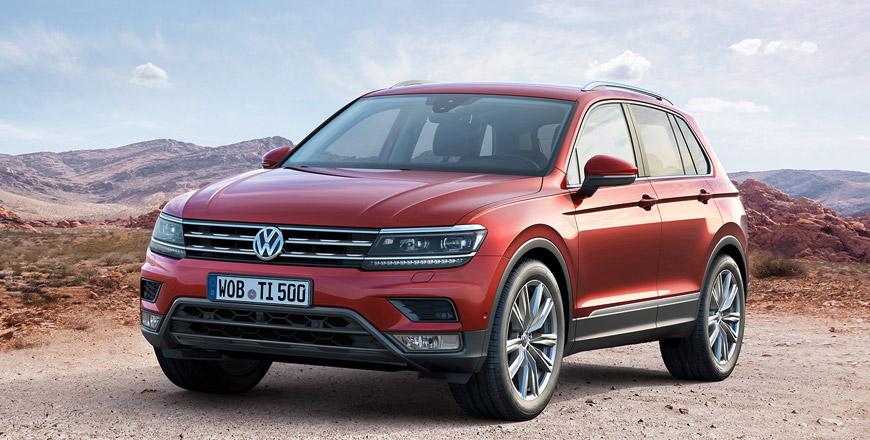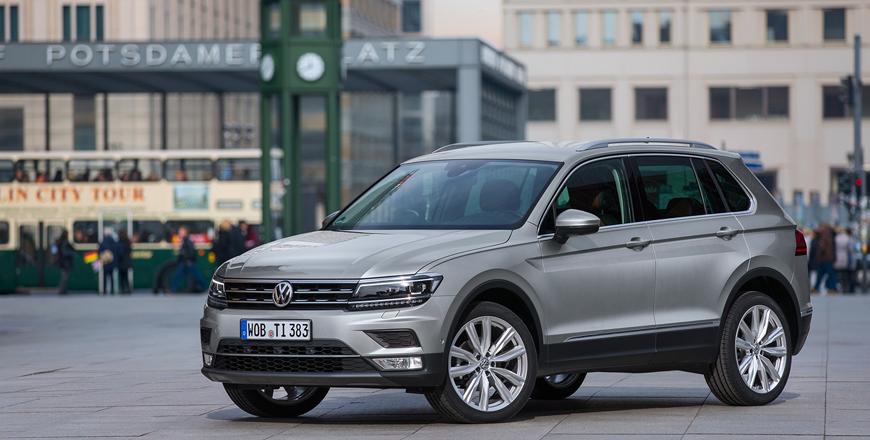You are here
Volkswagen Tiguan Sport 2.0 — edging ahead
By Ghaith Madadha - Jun 05,2017 - Last updated at Jun 05,2017

Photo courtesy of Volkswagen
A more upmarket successor to Volkswagen’s first compact crossover SUV – or CUV – endeavour, the second generation Tiguan is a classier design, more refined drive and technologically advanced effort.
Competes with both mainstream and premium ends of an ever more popular family car segment the new Tiguan launched globally in 2016 and early this year in the Middle East.
Offered regionally in five trim levels and three driveline options, Variations include 148BHP 1.4-litre front-wheel-drive with 6-speed dual clutch DSG gearbox and 2-litre four-wheel-drive 7-speed DSG versions developing 177BHP or 217BHP Tiguan Sport 2.0 specification, as driven.
Distinct and defined
Built on a larger CUV version of the same MQB platform underpinning its superbly well rounded Golf family hatchback sister, the new Tiguan similarly reaps the benefits from increased lightweight aluminium content. Though a little longer and wider — and shorter — the new Tiguan nonetheless sheds 50kg over its predecessor for improved efficiency, performance and driving dynamic.
A distinctly sharper edged, mature and evolved design, the new Tiguan has a more contiguous, classy and sporting style than the model it replaces, with a particular emphasis on straight and level lines, from fascia, waistline and side ridged character line.
With a greater sense of the dramatic, including more muscular and chiselled surfacing, the new Tiguan’s more lines and broad fascia also emphasise a perception of width. Its level grille and headlights seem moodier, with deep-set lamps browed by LED strips.
And with lower, descending roofline, justting spoiler, deeper lower front intakes, more defined sills and ridged character line extending to boomerang style rear lights, the latest Tiguan sits on the road with more presence and a sense of urgency. Driven in top Sport guise, the Tiguan features bumper integrated dual exhaust tips and larger more purposeful 19-inch alloys with 235/50R19 tyres.
Hot hatch heart
Powered by a turbocharged direct injection 2-litre four-cylinder engine the Sport 2.0 is the range-topping petrol version Tiguan, and comes with standard four-wheel-drive and 7-speed automated dual clutch gearbox. Borrowed from the Golf GTI hot hatch, it develops 217BHP at a broad 4500-620rpm band and muscular 258/b/ft torque throughout a wide and accessibly versatile 1500-4400rpm range. Refined and developed with efficient thermal management in mind, the Tiguan Sport’s engine spools up swiftly with only turbo lag from idling. More confident and noticeably quicker than 177BHP Tiguan models, the Sport is smoothly responsiveness, with flexibly confident mid-range and eager top-end.
Driving all four wheels and developing more traction from standstill, and with 7-speed DSG gearbox allowing for more aggressive lower gears, the larger heavier Tiguan Sport overcomes a 267kg weight disadvantage to match its nimble and more eager Golf GTI sister’s brisk 6.5-second 0-100km/h acceleration.
And while this does not translate into similar performance or economy across the board, the Tiguan Sport’s 220km/h top speed and 7.8l/100km combined fuel efficiency are however impressive for its class. With progress underwritten by a broad and generous torque band, the Sport’s DSG gearbox delivers seamlessly swift and smooth shifts when operating in a sequence, whether in auto or manual mode.
Reassuring and refined
Underpinned by a shared platform and engine, the Tiguan Sport 2.0 drives with a tidy and adept manner, however it is not exactly a CUV version of the agile and eager Golf GTI. A different sort of driving experience, the larger and heavier and four-wheel-drive Tiguan has a heavier and perhaps slightly more comfortable and settled ride. If not as nimble, eager, adjustable and connected to winding roads and corners as the GTI, the Tiguan is however smooth, precise and reassuringly benign in its handling. Well controlling weight shifts through corners, the Tiguan Sport, however, remains taller and more comfortably setup than a hot hatch, and expectedly leans more when pushed.
Smooth and composed with terrific ride refinement and stability, the Tiguan is settled on rebound and comfortable over long distances and over imperfections, feeling slightly only firm over jagged bumps in the road, as driven with larger alloys and lower profile tyres.
With light yet direct steering, high and alert driving position and good visibility aided by optional parking assistance and rear and around view cameras, the Tiguan is easy to drive and manoeuvre on road. Meanwhile, its front-biased four-wheel-drive system reallocates power rearwards when additional grip is needed through corners or on low tractions surfaces.
Classy quarters
A refined and comfortable car-like CUV with MacPherson strut front and multi-link rear independent suspension, the Tiguan is very much designed to be driven on road. However, it is nonetheless equipped with a brake based electronic differential lock and Active Control driving modes, which utilise stability and traction control systems, and alter throttle and gearbox responses to maintain loose surfaces.
It also features Hill Descent Control to aid driving off-road, while standard safety systems are comprehensive and optional driver assistance systems include adaptive cruise control with Front Assist system, which includes Pedestrian Monitoring and automatic braking to prevent or mitigate collision severity.
Well-equipped with electronic stability control suite with electronic brakeforce distribution, brake disc wiper and brake assistance, the Sport model can optionally be equipped with knee and side airbags, and includes heads-up display, digital instrument cluster.
Standard equipment also includes ISOFIX child seat latches, rain sensing wipers, ambient lighting, panoramic sunroof and folding rear tables. Uncluttered, user-friendly and classy inside, the Tiguan’s cabin features quality materials and construction. Instrumentation is clear and seating well adjustable, supportive and comfortable, with good space and access front and rear to accommodate taller passengers in a row or increase luggage capacity.
TECHNICAL SPECIFICATIONS
Engine: 2-litre, turbocharged, transverse 4-cylinders
Bore x stroke: 82.5 x 92.8mm
Valve-train: 16-valve, DOHC, direct injection
Gearbox: 7-speed dual clutch automated, four-wheel-drive
Power, BHP (PS) [kW]: 217 (220) [162] @4500-6200rpm
Specific power: 109.3BHP/litre
Power-to-weight: 130BHP/tonne
Torque, lb/ft (Nm): 258 (350) @1500-4400rpm
Specific torque: 176.4Nm/litre
Torque-to-weight: 209.7Nm/tonne
0-80km/h: 4.3-seconds
0-100km/h: 6.5-seconds
Top speed: 220km/h
Fuel consumption, urban/extra-urban/combined: 9.7-/6.7-/7.8-litres/100km
CO2 emissions, combined: 180g/km
Fuel capacity: 60-litres
Length: 4486mm
Width: 1839mm
Height: 1646mm
Wheelbase: 2681mm
Overhang, F/R: 896/909mm
Track, F/R: 1576/1566mm
Headroom, F/R (w/sunroof): 1004/967mm
Minimum ground clearance: 180mm
Cabin width, F/R: 1503/1491mm
Luggage volume, min/max: 615/1655-litres
Unladen weight, minimum: 1669kg
Steering: Electric-assisted rack & pinion
Turning Circle: 11.5-metres
Suspension, F/R: MacPherson struts/Multi-link
Tyres: 235/50R19
Related Articles
First launched in 2016, the second generation Volkswagen Tiguan was a distinct step up from its predecessor.
Launched globally in 2016 and arriving in the Middle East earlier this year, the second generation Volkswagen Tiguan’s physical growth may b
One of those few cars that tick so many boxes and do so much so well, the latest version the range-topping Volkswagen Golf R is practical but compact, refined but focused, nimble but grippy, classy but understated and scorchingly brisk but utterly civilised.


















